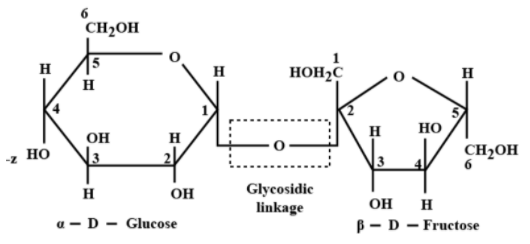
\[\left( + \right)\text{ }-\] sucrose is made up of:
a.D-glucose and L-fructose.
b.D-glucose and D-fructose.
c.L-glucose and D-fructose.
d.L-glucose and L-fructose.
Answer
516.9k+ views
Hint: We know that sucrose is a disaccharide that is formed by the addition of a glucose molecule and a fructose molecule by the formation of a glycoside bond between them, with the release of a water molecule from it. Thus, sucrose formation is a result of the dehydration process.
Complete step by step solution:
Sucrose is a natural polysaccharide with the molecular formula On \[{{C}_{12}}{{H}_{22}}{{O}_{11}}\] hydrolysis in acidic medium sucrose gives to two different monosaccharide’s which are Glucose and fructose
\[\underset{Sucrose}{\mathop{\left[ {{C}_{12}}{{H}_{22}}{{O}_{11}} \right]}}\,+\underset{Water}{\mathop{\left[ {{H}_{2}}O \right]}}\,\xrightarrow{{}}\underset{D-(+)-Glucose}{\mathop{\left[ {{C}_{6}}{{H}_{12}}{{O}_{6}} \right]}}\,+\underset{D-(-)Fructose}{\mathop{\left[ {{C}_{6}}{{H}_{12}}{{O}_{6}} \right]}}\,.\]
Predominantly glucose forms pyranose rings as it contains aldehyde \[\left( CHO \right)\] group at the end of the chain. The pyranose ring is a six-membered ring with five predominantly glucose forms pyranose rings as it contains aldehyde \[\left( CHO \right)\] group at the end of the chain. The pyranose ring is a six-membered ring with five carbon atoms and one oxygen atom in it. So, the glucose exists as a pyranose form in sucrose.
As the hemiacetal group and the hydroxyl \[~\left( -OH \right)\] group lie on opposite sides to each other in a glucopyranose ring, this pyranose form of glucose is named alpha pyranose. Hence the glucose unit in sucrose is -D-glucopyranose. But mostly fructose forms furanose rings as it contains ketone groups at the second carbon of the chain.

Therefore, the correct answer is option B.
Note:
Remember that for human consumption, sucrose is extracted and refined from either sugarcane or sugar beet. The sugar mills that are present in the tropical regions near where sugarcane is grown, the cane is crushed there and raw sugar is produced which is shipped to other factories for refining into pure sucrose and for the removal of toxic substances and impurities.
Complete step by step solution:
Sucrose is a natural polysaccharide with the molecular formula On \[{{C}_{12}}{{H}_{22}}{{O}_{11}}\] hydrolysis in acidic medium sucrose gives to two different monosaccharide’s which are Glucose and fructose
\[\underset{Sucrose}{\mathop{\left[ {{C}_{12}}{{H}_{22}}{{O}_{11}} \right]}}\,+\underset{Water}{\mathop{\left[ {{H}_{2}}O \right]}}\,\xrightarrow{{}}\underset{D-(+)-Glucose}{\mathop{\left[ {{C}_{6}}{{H}_{12}}{{O}_{6}} \right]}}\,+\underset{D-(-)Fructose}{\mathop{\left[ {{C}_{6}}{{H}_{12}}{{O}_{6}} \right]}}\,.\]
Predominantly glucose forms pyranose rings as it contains aldehyde \[\left( CHO \right)\] group at the end of the chain. The pyranose ring is a six-membered ring with five predominantly glucose forms pyranose rings as it contains aldehyde \[\left( CHO \right)\] group at the end of the chain. The pyranose ring is a six-membered ring with five carbon atoms and one oxygen atom in it. So, the glucose exists as a pyranose form in sucrose.
As the hemiacetal group and the hydroxyl \[~\left( -OH \right)\] group lie on opposite sides to each other in a glucopyranose ring, this pyranose form of glucose is named alpha pyranose. Hence the glucose unit in sucrose is -D-glucopyranose. But mostly fructose forms furanose rings as it contains ketone groups at the second carbon of the chain.

Therefore, the correct answer is option B.
Note:
Remember that for human consumption, sucrose is extracted and refined from either sugarcane or sugar beet. The sugar mills that are present in the tropical regions near where sugarcane is grown, the cane is crushed there and raw sugar is produced which is shipped to other factories for refining into pure sucrose and for the removal of toxic substances and impurities.
Recently Updated Pages
A man running at a speed 5 ms is viewed in the side class 12 physics CBSE

State and explain Hardy Weinbergs Principle class 12 biology CBSE

Which of the following statements is wrong a Amnion class 12 biology CBSE

Two Planoconcave lenses 1 and 2 of glass of refractive class 12 physics CBSE

The compound 2 methyl 2 butene on reaction with NaIO4 class 12 chemistry CBSE

Bacterial cell wall is made up of A Cellulose B Hemicellulose class 12 biology CBSE

Trending doubts
What are the major means of transport Explain each class 12 social science CBSE

Which are the Top 10 Largest Countries of the World?

Draw a labelled sketch of the human eye class 12 physics CBSE

State the principle of an ac generator and explain class 12 physics CBSE

Sketch the electric field lines in case of an electric class 12 physics CBSE

Give 10 examples of unisexual and bisexual flowers




